Insects attack all parts of the maize plant and attack the plant through all stages of plant growth. Numerous insect species attack maize in North America but the economic importance of the various species differs by region. The insects discussed are grouped according to the plant parts that they feed on: 1) Seed, Root and Lower Stem Feeders 2) Leaf Feeders and 3) Ear Feeders. This section examines those that attack leaves.
Insects feeding on the leaves of maize remove sap with sucking mouthparts, lacerate the leaves or remove a portion of the leaves. Aphids remove plant sap, thrips lacerate the leaves and cutworms, and armyworms and beetles remove portions of the leaves. All of these types of feeding remove chlorophyll resulting in reduced photosynthesis. Specific insects discussed in this section are: corn leaf aphid, spider mites, thrips, dingy cutworm, armyworm, grasshopper, corn flea beetle, and stink bug.
Corn Leaf Aphid

The wingless corn leaf aphid, Rhopalosiphum maidis (Fitch) adult, is oval and about 2.0 mm long (figure, left). It is usually green to bluish green with black antennae, legs, and cornicles and a dark area at the base of the cornicles. The head is marked with two dark, longitudinal bands, and the abdomen with a row of black spots on each side. The body often seems to have a powdery coating. The winged form is about the same size as the wingless form and has a dark green and black body and black cornicles. The nymph is smaller than but similar to the wingless adult in appearance.
Biology and Life Cycle
The corn leaf aphid is common wherever small grains and maize are grown in the United States and Canada, being especially abundant in the South. Its range extends throughout the tropical and temperate regions of the world. The corn leaf aphid is commonly found on maize, barley, millet, broomcorn, sorghums, Sudan grass, and many other wild and cultivated grasses. It shows a preference for barley and sorghums. Although this aphid has been reported to attack wheat, oats, and rye, economically significant infestations on these crops are uncommon.
Little is known about the biology of this pest. Apparently it only overwinters in the southern states as an adult. Infestations in northern areas are believed to result from populations of winged forms carried by air currents from the south. Ovoviviparous (producing living young by the hatching of the ovum while still in the mother) females, both winged and wingless, form the bulk of the population. Males are rarely found, and no eggs have ever been seen. This suggests that the aphid can reproduce parthenogenetically (asexually). The female aphids and molted skins are found in large clusters on the leaves (figure, left), where the females feed and reproduce. Reproduction slows in winter and summer and is most rapid during cool weather. Therefore, corn leaf aphids tend to be a problem on winter grains in the fall, on warm winter days, and in the spring. The number of generations per year varies from 9 in Illinois to 50 in southern Texas.
Damage

The corn leaf aphid injures maize by the removal of plant sap and the introduction of diseases. Feeding by colonies of this aphid causes mottling and discoloration of the leaves. Feeding of large colonies in the vascular system causes an accumulation of carbohydrates and abnormal synthesis of anthocyanin resulting in the reddening of the leaves. Infested plants become covered with sweet, sticky honeydew secretions. Sooty mold fungi grow on the honeydew causing reduced grain development and interfere with photosynthesis. These aphids also transmit a mosaic disease of sweet corn.
Wingless colonies first are observed on the emerging leaves and the tip of the tassel. The winged form is observed when colonies on the leaves and tassels increase in size at pollen shedding and silking time. Prior to tassel emergence, the nymphal infestation occurs on the moist part of the leaves in the whorl where they feed on the phloem. If infestations begin early in the season on mid-whorl maize and increase to large colonies by the time of tassel emergence, anthesis is affected and varying degrees of missing kernels may occur.
Spider Mites
Description
Spider mites are small microsocopic arthropods belonging to the class Araneida, and the order Acarina. They differ from insects in having 8, rather than 6 legs in the adult stage. There are several spider mite species that attack maize in North America. These include the twospotted spider mite Tetranychus urticae Koch, Banks grass mite Oligonychus pratensis (Banks), carmine spider mite, Tetranychus cinnabarinus (Boisduval) and the Pacific spider mite, Tetranychus pacificus McGregor.
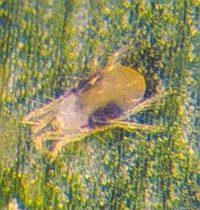
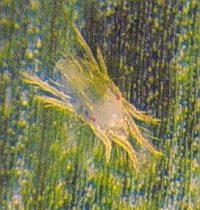
Two species of spider mites, the twospotted spider mite, and the Banks grass mite, damage maize in Nebraska. They are somewhat similar in appearance but differ in the amount of damage they cause. Proper mite identification is important since the twospotted spider mite is much more difficult to control. The most useful characteristic for differentiating between these two species is the pattern of pigmentation. Generally, in older twospotted spider mite females, pigmentation appears as a well-defined spot on each side of the body, ending abruptly just beyond half the length of the body (left figure). The two dark spots on the sides of the abdomen are digested food visible through the mite's translucent body. Banks grass mite females tend to have blackish-green pigmentation extending the full length of the body (right figure). The twospotted spider mite is about 0.4 mm long. The oval-shaped female is yellow to dark green, with two or four dark, dorsal spots; the male is smaller and has a more pointed abdomen. The eggs are spherical, and white to transparent when first laid. Just before hatching, they become a yellowish-green color and average 0.14 mm in diameter. The larvae (first stage after hatching) are slightly larger than the eggs. They are six-legged and colorless except for carmine eyespots. The two nymphal stages are difficult to distinguish. Both are pale green, oval, and eight-legged, sometimes spotted, and slightly smaller than adults.
Biology and Life Cycle
Twospotted spider mites have been found on over 180 host plants, including at least 100 cultivated species. Spider mites have four stages of development: (1) the spherical, somewhat translucent egg stage; (2) a six-legged translucent larval stage; (3) an eight-legged nymphal stage; and (4) the eight-legged adult stage. A resting or quiescent stage occurs at the end of the larval and nymphal stages.
Spider mites usually overwinter as fertilized females resistant to low temperatures. These females are red as opposed to the active summer forms which are yellowish-green. In mild winters, they may continue to feed and lay eggs. In summer, many generations (7 or more) develop. The number of eggs laid is dependent on the temperature. In warm weather, each female produces up to 19 eggs per day for a total of about 100 eggs over several days. Eggs are fastened to leaves or to silk spun by the adult mites and hatch in 2 to 4 days. Eggs hatch into six-legged larvae that next develop into eight-legged nymphs. There are two nymphal stages. After the larval, and each nymphal stage, a resting stage occurs. Adults mate soon after emerging from the last resting nymphal stage. Development is rapid in hot, dry weather. A generation requires 1 to 4 weeks and may pass in as few as 5 to 7 days in mid-summer, or in a month during cool periods.
Damage
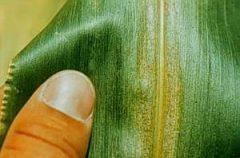
Banks grass mites appear earlier in the season and are more likely to remain on lower leaves. Twospotted spider mites appear later in the season and may spread rapidly over the entire plant. Weather and natural enemies appear to be important determining factors in spider mite abundance. Spider mites are most likely to develop economically damaging populations in fields that are moisture-stressed during June and July, particularly if weather is hot, windy, and dry. Mite build-up can occur even in irrigated fields, especially if irrigation problems exist or if irrigation is delayed during stress periods prior to the blister stage of maize. Other fields likely to develop mite problems are those that have received foliar applications of certain insecticides for European corn borer, western bean cutworm or other pests and fields located next to grasses, ripening wheat or alfalfa.
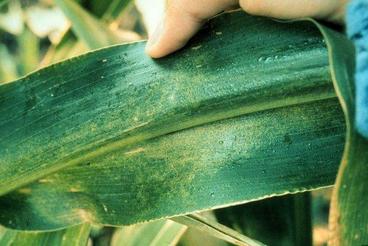
All active stages of spider mites damage maize by piercing plant cells of the leaf with their mouthparts and sucking the juices. Feeding causes premature drying that results in loss of leaf tissue, stalk breakage, and kernel shrinking. Effects on yield are most severe when mites damage leaves at or above the ear level. Evidence of mite feeding, which is visible on the upper surface of the leaf, is a yellowish and stippled area where the mites are feeding on the lower leaf surface. Heavily infested leaves turn completely pale and dry up. Both the Banks grass mite and the twospotted spider mite produce webbing on the lower leaf surface in which the various stages of the mites are present. Webbing is initiated near the midribs of the host plant and gradually envelopes the plant as the population increases. Severe infestations resemble drought stress since damage progresses from the bottom of the plant up. Spider mites can be a serious problem on maize, particularly silage and sweet corn.
Thrips
Description
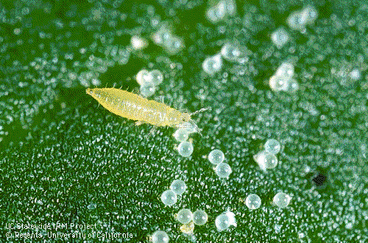
Thrips attacking maize include the western flower thrips, Frankliniella occidentalis (Pergande) and the corn thrips, Frankliniella williamsi Hood. The western flower thrips adults are very small, about 1 mm long. Wings are narrow and fringed with long hairs. The female is larger than the male, varies from yellow to dark brown, and has a more rounded abdomen. The male is always pale yellow and has a narrower abdomen. The eggs are yellowish and not visible because they are laid into the plant tissue. Immature thrips are wingless, whitish to yellowish in color (figure left). The larvae develop through two instars. Second instars become whitish prior to molting. Both, the prepupa and pupa, are yellowish, quiescent non-feeding stages.
Biology and Life Cycle
Thrips metamorphosis is intermediate between simple and complete and consists of five stages: adult, egg, larvae, prepupa, and pupa. There are two larval instars. Both prepupa and pupa are quiescent, non-feeding stages. Adults emerge continuously throughout the warm months. Adults and immatures may be found in maize at any time during the growing season. Eggs are deposited in tender plant tissue and hatching occurs in 2 to 14 days, depending on temperature (about 5 days during the summer months). First instar larvae begin feeding soon after hatching. The immature stages take about 5 to 7 days to complete development. Thrips develop through two quiescent, non-feeding pupal stages in the soil, plant litter or in a protected area on the plant. The entire life cycle from oviposition to adult emergence ranges from 12 days in hot weather to 44 days in cool weather.
Damage
Thrips build up on alfalfa, weeds, and other vegetation in spring, and then move to maize from these hosts when they are cut or dry up. Thrips are most commonly found in whorls, tassels, ears, or on the underside of leaves. They feed by inserting their modified left mandible into the tissue, and sucking the fluids from cells. Thrips are most noticeable and cause most severe damage at two maize growth stages, young seedling plants and at ear formation. Feeding on young seedlings stunts plants. A common sign of a heavy thrips infestation is distorted leaves that turn brownish around the edges and cup upward. Usually the plants will recover. At ear formation, thrips injury provides entry for infection by Fusarium spp. and subsequent Fusarium ear rot diseases. The actual thrips injury does little damage but ear rot diseases can be serious.
Dingy Cutworm
Description

The dingy cutworm, Feltia jaculifera (Guenée) larvae are a dull pale gray to reddish brown color with a broad gray dorsal stripe, subdivided into V-shaped areas on each segment and margined by a narrow dark stripe on each side (figure). The larvae are similar in appearance to those of the black cutworm. They, however, differ from the black cutworm larvae in that they have four black tubercles (warts or spots) on each abdominal segment which are equal in diameter, while in the black cutworm, the front pair of tubercles are about half the diameter of the back pair. Larvae are about 32 mm long when full grown. The adult is gray with distinct whitish gray markings on each forewing. The hindwing is grayish brown with a white fringe and a wingspan of 30 to 40 mm. Eggs are white and oval-shaped. The pupa is brown and oblong.
Biology and Life Cycle
Dingy cutworms are northern species found from southern Canada through the upper two-thirds of the of the United States from southern Utah to southern Virginia on the south and from the east coast to Idaho and Utah in the west (figure). Dingy cutworms overwinter as larvae. In early spring, larvae become active and feed in weedy areas of fields. Fourth through sixth instars are present when maize is planted and seedlings develop. Mature larvae undergo summer hibernation (aestivation) from mid-May until July, then pupate just beneath the soil surface from late July through mid-August. Moths emerge during August and September and the females lay eggs on host plants. Eggs are laid singly or in groups of a few. There is one generation per year.
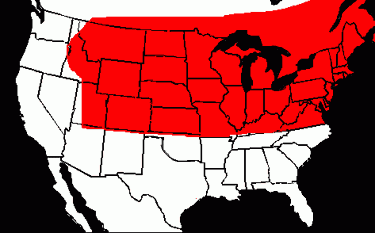
Damage
Dingy cutworm larvae have a wide host range feeding on many plant species, including maize, wheat, alfalfa, grasses, and broadleaf weeds. They are most common in fields following legumes or in fields with heavy crop residues and are among the first insects to damage maize in the spring. Dingy cutworms are climbing cutworms that feed almost entirely on leaves (especially the ends) and seldom cut or bore into seedling maize. Thus, they cause less damage than the black cutworms which may feed on the leaves and cut the stems.
Armyworm
Description
The true armyworm, Pseudaletia unipuncta (Haworth) moth has pale brown to grayish-brown forewings with a wingspan of about 39 mm. There is a distinct white spot in the center of each forewing. The hind wings are grayish-white. The egg is greenish-white and globular. The young larva is pale green. Late instar larvae vary in color from green to light brown (see figures).
Longitudinal stripes are as follows: a narrow broken stripe down the center of the back, bordered by a wide, darker, mottled stripe reaching halfway to the side; on the side there are 3 stripes of about equal width; next to the mottled one on the upper side is a pale-orange, white-bordered stripe, next a dark brown stripe just reaching the spiracles; and just below the spiracles, there is a pale-orange stripe edged with white. Each proleg has a dark band on the outer side and a dark tip on the inner side. A mature armyworm is 30 to 35 mm long. The head is brown with dark honeycombed markings. The pupa, about 13-mm long is reddish-brown at first, and gradually darkens becoming black.
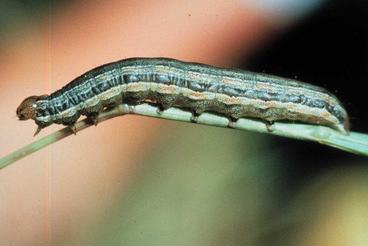
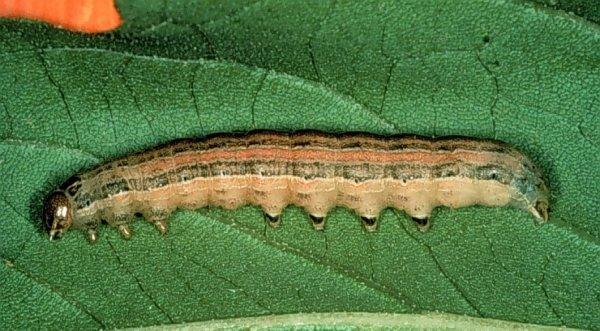
Biology and Life Cycle
The armyworm is found in California, New Mexico, Arizona, and in all states and in Canadian provinces east of the Rocky Mountains. In the southern states, partially grown larvae overwinter in soil near the surface. The insect does not overwinter in the northern states. The adults migrate to these areas each year from mid to late May. Early in the spring, larvae resume feeding at night, usually on grasses and small grains. During daylight hours, larvae prefer to remain under litter on the ground. The larvae pupate and the adults emerge. First generation adults appear in May or June depending upon climatic conditions. Moths mate soon after emergence and feed on nectar for 7 to 10 days. Within about 21 days after emergence, at night, females deposit up to 2000 eggs on the leaf sheaths of grasses and small grains which usually grow near maize fields or around field margins. Eggs are laid in masses or rows of 30 to 75, often with the edge of the leaf folded over them. About 8 days later, larvae emerge and feed for 3 or 4 weeks on the foliage of grains and grasses. After stripping the grasses, the larvae invade adjacent maize fields. Occasionally, when herbicides fail to control grassy weeds within maize fields, armyworm moths may lay eggs throughout the maize field, resulting in an outbreak. After feeding, mature larvae drop to the ground and pupate in earthen cells 5 to 8 cm deep within the soil. Moths emerge about 2 to 4 weeks later. True armyworms complete about 3 generations per year in most locations but in extreme southern locations, there are continuous generations.
Damage
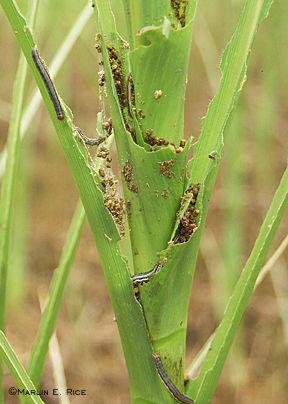
The armyworm is a pest of maize, sorghum and small grains. In maize it is a common early season pest of maize. Damage to maize consists primarily of stripping of the leaves. Larvae may feed on the ear causing injury similar to that of the corn earworm but damage to the ear is usually slight. Armyworm infestations are noted for their rather sudden appearance in large numbers.
Armyworms feed on the maize foliage starting with the edge of the leaf. Feeding starts on the lower leaves and progresses up the plant. The whorl leaves are eaten last. Depending on the plant size, armyworms may completely defoliate to the point that onlythe leaf midribs remain. In the case of heavy infestations, armyworms may devour plants to the point that only stubble remains. Because they feed at night, the larvae may inflict much injury before they are detected. Once having exhausted their food supply, larvae migrate to new host plants. Field borders are typically more severely damaged. Armyworms often cause problems in maize when grassy areas of fields are destroyed by cultivation or by herbicides, or when maize is planted no-till into wheat or rye. In some northern states, the second and third generation larvae often are most injurious to maize, especially in fields that have an abundance of grassy weeds.
The armyworm does not overwinter in the upper-Midwest, but reinvades the northern part of its range each spring. Armyworm outbreaks in Texas, Missouri, Oklahoma or Kansas indicate a potential invasion of Nebraska and other states to the north. Damaging infestations, however, may occur despite low numbers of migrating moths. Conversely, large moth flights into the Midwest do not always result in economic infestations. The high reproductive potential of this insect and complex environmental factors determine the ultimate degree of infestation.
Grasshoppers
Description
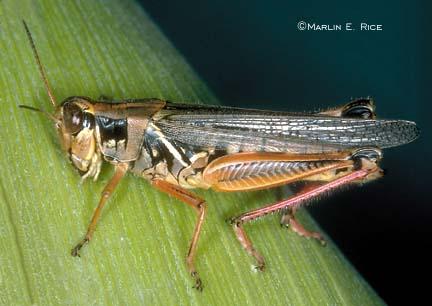
In the Midwest, four grasshopper species -- the differential, Melanoplus differentialis (Thomas); redlegged, M. femur-rubrum (De Geer); migratory, M. sanguinipes (F.); and twostriped, M. bivittatus (Say)-- cause about 90 percent of the total damage to cultivated crops. Grasshopper species are generally similar in appearance. The differential grasshopper (figure, left) is one of the largest of the crop destructive species in North America reaching a length of 45 mm. Adults and nymphs are brownish or olive green with yellow areas on the lower parts and black chevron-like markings on the hind legs. The redlegged grasshopper is smaller, about 25 mm long, brownish red with the hind tibiae pinkish red with black spines (figure, left). The migratory grasshopper is similar in appearance to the red-legged but the hind tibiae is not as bright pink as the red-legged. The twostriped grasshopper is about 35 mm in length. The upper part of the body is olive colored with a yellow stripe on each side, extending from the head to the tip of the wing. It is distinguished by the dark stripe on the upper half of the hind leg. Grasshopper eggs are laid in masses (egg pods) about 25 m long consisting of up to 30 elongate eggs cemented together (figure, below).
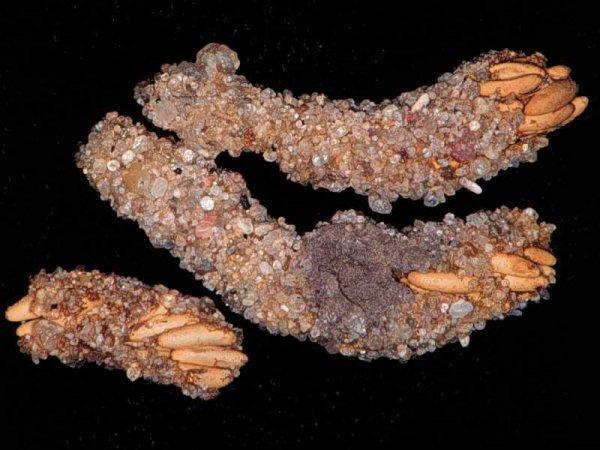
Biology and Life Cycle
There are three stages in the grasshopper life cycle -- the egg, nymph, and adult. The number of egg pods deposited by a single female may range from 7 to 30, and the number of eggs per pod may vary from 8 to 30, depending on the species. The eggs are well protected by the insulation of the pods and can survive extremely cold temperatures. Some grasshoppers prefer to lay eggs in soil surrounded by roots of grasses; other species select open areas in locations with accumulations of surface debris. Grasshoppers in croplands only lay their eggs in untilled soil. Therefore, to infest a crop the grasshoppers have to migrate from field margins or other areas of untilled soil. Most grasshoppers overwinter in the egg stage, but a few species hibernate as nymphs.
Hatching time is influenced by weather. Hatching time can be predicted by correlating the four developmental stages of eggs (clear, coagulated, eye spot, and segmented) with soil temperatures. Eggs hatch about the middle of May in Nebraska. Most nymphs start feeding within one day after egg hatch, and usually feed on the same plants as the adult. The nymphal stages require about 6 weeks and adults begin appearing in early July. Hoppers begin laying eggs one to three weeks after becoming adults, starting in early August. They may live 45 to 50 days.
Damage
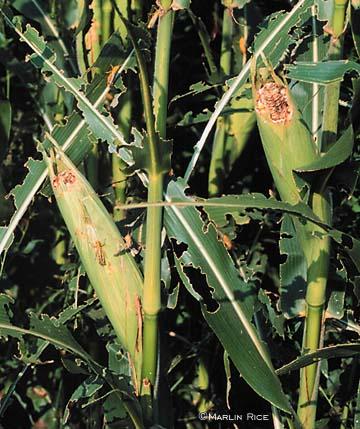
Because many of the grasshopper breeding areas are now under tillage, the potential for devastation, while still serious, is not as great as it was 100 years ago. In the Midwest, cropland grasshoppers feed primarily on maize, wheat, and alfalfa, but during years of high populations, may feed and seriously damage any crop as well as trees and shrubs. Feeding may begin anywhere on the plant but rarely on the bottom leaves. Injury may start at the leaf edge or in the center of the leaf adjacent to the midrib. There is no pattern to the feeding. Very large populations consume all the leaf except for the tougher leaf midrib. Injury is similar to that caused by armyworms, but armyworms start feeding on the bottom leaves and progress up the plant. Defoliation is the primary injury to plants, but damage often exceeds the amount of foliage eaten. Grasshoppers may also feed on ripening kernels of grain, causing shattering. In addition, they feed on the green silk, preventing fertilization or filling of the ear.
Corn Flea Beetle
Description
There are a number of flea beetles attacking maize but the corn flea beetle Chaetocnema pulicaria Melsheimer and sweet potato flea beetle C. confinis Crotch are of major importance in North America. Other flea beetle species feeding on maize in the western USA are the western black flea beetle, Phyllotreta pusilla Horn; the potato flea beetle, Epitrix cucumeris (Harris); threespotted flea beetle, Disonycha triangularis Say; and the palestriped flea beetle, Systena blanda Melsheimer.
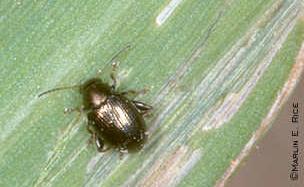
The corn flea beetle adult is oval-shaped, 1.3- to 2.5-mm long, and black colored tinged with bronze or bluish-green and has yellow markings on its legs. The basal segment of each antenna is orange. Flea beetles have enlarged hind legs and jump vigorously like fleas when disturbed. The white egg is about 0.35 mm long and pointed at one end. Larvae are white, slender, and cylindrical grubs with a brown head and small legs. Larvae are 3.2 to 8.5 mm long when full grown. The white pupa resembles the adult in size and gradually darkens as it matures.
Biology and Life Cycle
The corn flea beetle occurs in most areas east of the Rocky Mountains. It is a general feeder, but most hosts are grasses. The corn flea beetle overwinters as an adult beetle in litter and trash around fields. In early spring, the beetles move to weeds and then to maize seedlings. Eggs are scattered on the soil beneath host plants. In about 10 days, the larvae emerge and begin feeding on and tunneling in underground stems, roots, or tubers. They feed for 3 to 4 weeks and develop through three instars before pupating in the soil. In 7 to 10 days, a new generation of adults emerges. Three or more generations are completed each year.
Damage
Corn flea beetles attack foliage, leaving small round holes and scraped or striped areas (see figure above). In young plants particularly, the feeding damage can be serious and can result in death. Usually, the direct loss caused by these injuries is relatively insignificant. These beetles are usually most troublesome after a mild winter followed by a cold spring. Under such conditions, high numbers of beetles survive the winter and attack the slowly growing maize over a prolonged period. Growth is retarded and leaves may wilt. Early maturing varieties in the middle and southern states are most seriously affected.
Economic damage primarily results from the overwintering beetles which spread bacterial wilt of maize (Stewart's disease). Stewart's disease of maize is caused by the bacterium Erwinia stewartii that causes a fatal wilt disease in young plants of sweet corn and certain susceptible field maize inbreds. Most common is the appearance of the leaf blight phase, which affects most dent maize inbreds and hybrids after pollination. Stewart's disease symptoms on leaves are long, wavy streaks that are water-soaked, then turn yellow and die.
Stink Bug
Description
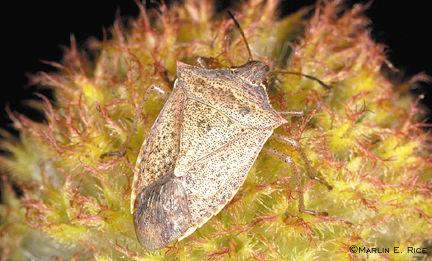
Several species of stink bugs (Hemiptera: Pentatomidae) feed on maize. Among the more common species are the brown stink bug, Euschistus servus (Say) (see figure), green stink bug, Acrosternum hilare (Say), and the southern green stink bug, Nezara viridula (L.). Brown and green stink bugs have been reported as far north as Quebec. In the United States, however, they are more often injurious in the South. Although the southern green stink bug occurs outside the United States, in this country it occurs only from Texas to the Atlantic coast and northward to Virginia.
Stink bugs are known for their foul odor. They are shield-shaped insects with five-segmented antennae and a large scutellum (triangle) on the center of the back (see figure). The color patterns vary with the species.
When first laid, the barrel-shaped eggs of the green stink bug are yellow to green, later turning pink to gray. Eggs of the green stink bug measure 1.4 x 1.2 mm. The white, kettle-shaped eggs of the brown stink bug are slightly smaller than those of the green stink bug. The creamy, cylindrical eggs of the southern green stink bug measure 1.0 by 0.75 mm and develop a pinkish hue before hatching.
Nymphs resemble adults but are smaller. Green stink bug nymphs are predominantly black when small, but as they mature, they become green with orange and black markings. Nymphs of the brown and southern green species are light green. Southern green stink bug nymphs, however, have two series of white spots along their backs.
Adults of the various species range in size from about 12 to 19 mm in length. Green and southern green stink bugs are bright green and measure 14.0 to 19.0 mm long. The major body regions of the green stink bug are bordered by a narrow, orange-yellow line. Brown stink bugs are dull brownish-yellow in color and 12.0 to 15.0 mm long.
Biology and Life Cycle
Stink bugs overwinter as adults and become active in spring. Each female deposits up to several hundred eggs, usually in early summer. These eggs are laid in clusters primarily on leaves and stems. Nymphs hatch from these eggs and pass through five instars before becoming adults. Approximately 5 weeks elapse between hatching and adult emergence. The number of generations per year varies in different regions of North America.
Damage
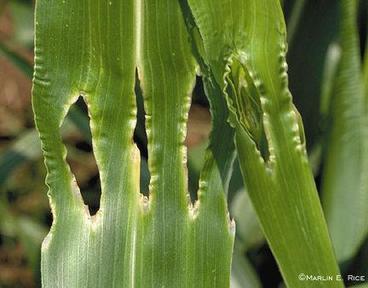
Stink bugs have a wide host range. On maize, damage is generally most severe in weedy fields. Both the adults and nymphs suck sap. Stink bug feeding causes several types of damage. Feeding early in the early maize growth stages (VE--V5) may kill small seedlings, produce stunted plants, or cause excessive tillering. Stink bugs kill seedling plants by injecting a toxin during feeding. Leaves may be wrinkled with holes of various sizes, scattered randomly or in repeating patterns often with a yellow halo; whorl leaves wrapped tight and failing to expand. Stink bugs pierce the side of the stalk with their beak. Saliva injected into the leaf during feeding creates holes. There is usually a row of oval holes with yellow borders across the unwrapped leaves of damaged plants. This row results from the single feeding puncture that penetrates the wrapped leaves. Holes are up to 25 mm on expanded leaves and are often surrounded by dead, brown tissue and a yellow halo (figure above). Feeding patterns are often repeated across the leaf. Injured leaves are often twisted. The most dramatic symptom is tillering of damaged plants. Tillering is first observed about 10 days after damage occurs. A shoot begins to grow from the base of the plant and may become as large as the original plant.
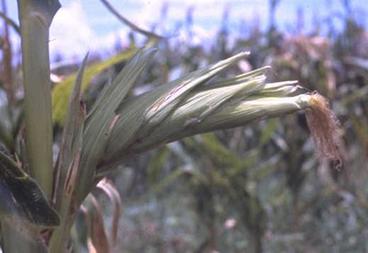
Stink bugs also probe through the shuck of a developing ear of corn and suck the juice from individual kernels. This damage may open entrances for other insect pests or fungi to cause extensive damage. Feeding may cause twisted ear shoots with separated husk leaves (figure, left) and with missing grains, mostly on the ear surface away from the stalk. Stylet (feeding) marks can be seen on the inside of green shucks and appear as pin-point bruises. The greatest damage, however, occurs when stink bugs feed on ears that are less than 20 mm long, beginning about 2 weeks before silking. This damage may result in total ear loss by causing curled ears.